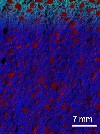 - Building & Fire Research
- Building & Fire Research Find out what NIST is currently working on in Building & Fire Research.
Jack Pevenstein
Technology Partnership Office
301-975-5519
nisttech@nist.gov
100 Bureau Drive, M/S 2200
Gaithersburg, MD, 20899

A non-destructive method enables the detection of moist areas located inside a building wall or the like. A transmitter generates a series of ultra-wideband pulses that are sent to an antenna unit, preferably in the form of an array that includes a plurality of switchable antenna pairs. The antenna unit directs the pulses toward the building structure and receives pulses that are reflected from the structure. Computational algorithms process the reflected pulses received by the antenna unit and produce an output, typically in the form of visual map that can be used to identify the locations of excessive moisture in the wall or structure.

A magnetoresistive sensing apparatus is disclosed, comprising a magnetic film having a zig-zag shaped structure, a central axis, and a magnetization associated with the magnetic film, wherein the zig-zag shaped structure biases the magnetization direction alternately at positive and negative angles thereof, thereby permitting the magnetoresistive sensing apparatus to be sensitive to a magnetic field parallel to the axis of the magnetoresistive sensing apparatus and insensitive to magnetic fields perpendicular to the axis.
A Gd.sub.5Ge.sub.2Si.sub.2 refrigerant compound is doped or alloyed with an effective amount of silicide-forming metal element such that the magnetic hysteresis losses in the doped Gd.sub.5Ge.sub.2Si.sub.2 compound are substantially reduced in comparison to the hysteresis losses of the undoped Gd.sub.5Ge.sub.2Si.sub.2 compound. The hysteresis losses can be nearly eliminated by doping the Gd.sub.5Ge.sub.2Si.sub.2 compound with iron, cobalt, manganese, copper, or gallium. The effective refrigeration capacities of the doped Gd.sub.5Ge.sub.2Si.sub.2 compound are significantly higher than for the undoped Gd.sub.5Ge.sub.2Si.sub.2 compound.

The invention consists of a unique method to reduce diffusion rates in concrete by increasing the hydrodynamic friction on ionic species in the concrete pore solution. This novel approach involves changing the properties of the pore solution, rather than the microstructure. Conventionally, diffusion rates for concrete structures have been reduced by densifying the cement paste matrix component of the concrete via a reduction in water-to-cement ratio and/or the addition of fine pozzolanic materials such as silica fume and/or fly ash. Still, in every case, the pathways for diffusion are through the interconnected pore solution that saturates the porosity at all scales. By appropriately increasing the hydrodynamic friction, the diffusion rates of all ionic species (sulfates, chlorides, alkalis) can be reduced. Theory indicates that these diffusion rates will be inversely proportional to the solution's hydrodynamic friction coefficient, so that doubling the hydrodynamic friction will reduce the diffusion coefficients by a factor of two, which in turn should lead to a doubling of the service life for many degradation modes (sulfate attack, corrosion, etc.).